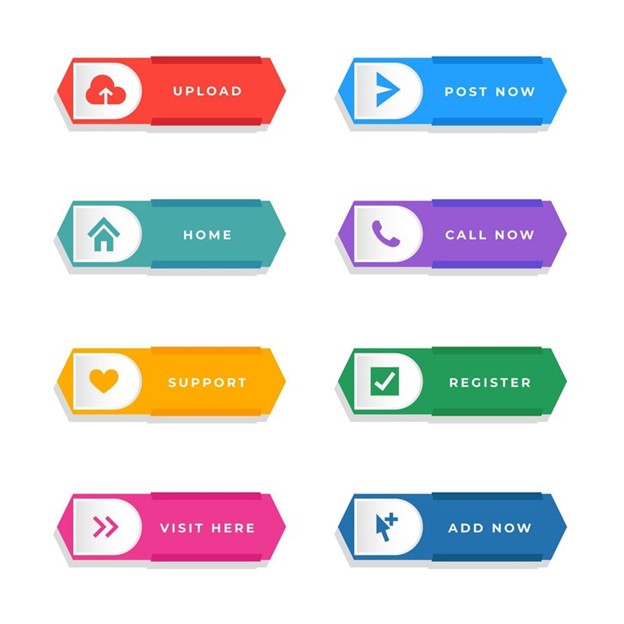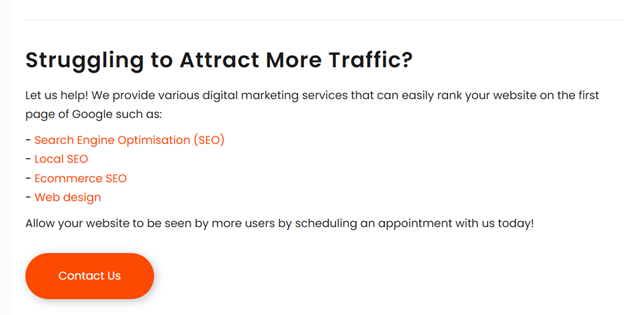Creating engaging content is a must for any digital marketing strategy in Singapore. In today’s era, getting noticed is not as easy as a decade ago. However, you can stand out if you can find the common content creation mistakes you are following.
If you are finding it difficult to avoid content creation mistakes, we are here to help you. Avoid these common content creation mistakes, and you are good to go.
In Singapore’s dynamic digital landscape, technological advancements and shifts in consumer behaviour have fueled the demand for content creation. When content fails to resonate with audiences, it can severely impact the return on investment (ROI), a metric for businesses operating in a competitive market.
All stakeholders in Singapore’s content marketing ecosystem—content creators, marketers, and agencies alike—must remain vigilant about common mistakes that can harm content quality.
Let’s explore common content creation mistakes prevailing in the Singaporean market and delve into actionable strategies to avoid content creation mistakes.
Top 10 Content Creation Mistakes That Impact ROI
Below, we have mentioned the most common mistakes that can hurt your content quality and eventually decrease ROI:
1. Not understanding your target audience
One of the most common content creation mistakes is not understanding your target audience. This can lead to creating content that doesn’t resonate with them, which can have many negative consequences.
The first negative impact is you will get low engagement and fail to capture the audience’s attention. Also, you will not effectively deliver the message because you lack understanding of their preferences, emotions, and needs. As a result, you will miss the opportunities to convert leads into your customers, negatively impacting your ROI.
Besides, creating content that doesn’t resemble your target audience is a waste of time, resources, money, and effort. Overall, not understanding your audience will make it difficult to reach your business goal, which is a huge disadvantage.
2. Lacking clear objectives or goals
Your content creation process might impact your ROI if you have unclear direction and lack clear goals. While you embark on your content creation journey without clear content creation objectives or goals, your content will miss the consistency and focus on spreading the messages. Further, your content will fail to deliver impactful messages, and people might find it confusing. Ultimately, you will also not find clear benchmarks for evaluating your performance and assessing whether your content brings positive returns.
Not only that, but without specific goals in mind, you will risk the valuable resources of your business, such as money, time, and human resources. Also, your efforts will not align with the border of your business objectives.
Thus, clear content creation objectives serve as a strong base for content creation and lead to cohesive content development.
3. Not providing value in content
Prioritising personal preferences over audience needs remains one of the most frequently repeated mistakes brands make in content creation. Overlooking the fundamental principle of audience-centricity can swiftly undermine even the most well-intentioned content efforts, making them ineffective and unable to achieve the desired impact.
If your content lacks value, it can lead to low engagement and interest among your target audience. This number will decline if you are active on social media platforms that allow your audience to like, share, and comment on your content. Why would they share content that doesn’t provide any value to them or to their circle?
Besides, you will lose trust and credibility when your content is uninteresting or irrelevant. This will damage your reputation, and your audience will perceive your content as unreliable or lacking in expertise. As a result, their chance of engaging with your content in the future will likely decline.
4. Vague headings
The heading is the first thing people see before reading any content. A clear heading can grab the attention of large audiences, while an unclear heading can be confusing and don’t help conversion.
Vague headings also disturb your ranking in search engines because headings are one of the most essential metrics for SEO. When your heading is vague and doesn’t clarify what your content is about, the search engine finds it harder to interpret and eventually doesn’t rank.
For example, if the heading of our article were long and vague, you would not read the article. Instead of “Content Creation Mistakes That Impact ROI,” if we had used the heading below, our content would not get as many views as it does now.

Even though your content inside is top-notch, if you fail to craft a good heading, it doesn’t help increase engagement. Readers will skip your content and might not return to see it; this is why on-page SEO is so important.
5. Not having consistency in creating content
As you get your hands on content creation, you should match your content with your niche and be consistent. For example, you have a digital marketing agency and write about digital marketing. But if you publish marketing-related content one day and real-estate content on the other day, that’s a red flag.
People come to your content if you are prominent in providing consistent content on your niche. Besides, publishing one content today and the next one after 3-4 months will not work. If you want to grab your audience’s attention, you should regularly publish your content. It might be daily, weekly, bi-weekly, or anything as such, but you should be consistent.
Maintaining audience engagement, building brand recognition and trust, building authority, and leading will be difficult without consistency.
6. Not using SEO optimisation
Search engine optimisation is a must if you want a higher rate or ROI because that’s how a search engine operates. Before your content finds its way to your target audience, search engines index them. If your content does not follow SEO techniques to rank higher in search engines, your content will never reach your target audience.
SEO strategies should be used from head to bottom of your content to get a good rank on search engine result pages (SERPs). SEO best practices include researching keywords, optimising titles, headings, subheadings, meta descriptions, images, and content structure, and using quality backlinks and internal links. Besides, it would be best if you also looked into technical SEO, such as site speed and off-page SEO.
7. Not using tracking traffic and analytics to evaluate content creation impacts.
Tracking traffic and analytics helps you evaluate the impact of your content creation efforts. If you don’t track them, you’re taking a step backwards in making data-driven decisions and optimizing your content.
Without data and relevant metrics, you will have no way to measure the success of your content or the ROI. It also becomes difficult to justify the continuous investment of your resources in content and identify the areas needing improvement.

Many analytics tools help you identify your audiences’ behaviour, such as how they interact with your content and how much time they spend on it. Without the data and metrics, finding and resonating with the audience’s preferences is impossible. Meanwhile, you will also miss the opportunity to compare your ROI with those of your competitors.
8. Creating lengthy and extravagant content
People enjoy short and to-the-point content as we take a leap with technological enhancement. If you are still creating lengthy and extravagant content, drop it immediately. Even though long-form and in-depth content provides value, overindulging in lengthy content with complexity does not lead to increased ROI.
In the fast-paced digital world, lengthy content becomes overwhelming and leads to decreased engagement and increased bounce rates. Most online audiences tend to search for specific information or something that is short, concise and provides exact information.
Meanwhile, creating lengthy and extravagant content wastes your time and resources. Such content tends to miss the core value and lose its charm. Thus, it is essential to tailor your content to your audience’s preferences and consumption habits.
9. Irrelevant graphics
One of the biggest content creation mistakes is incorporating irrelevant graphics. Adding visuals into content demands careful planning, as irrelevant graphics can prove detrimental. They can divert the audience’s attention from the core message, causing confusion or diluting the intended meaning.
Using visuals unrelated to the content can also erode the creator’s credibility and professionalism, suggesting a lack of effort or comprehensive understanding of the subject matter. Furthermore, creating or sourcing graphics is often resource-intensive, making irrelevant visuals a wasteful endeavour that fails to enhance the content’s effectiveness.
Additionally, audiences may mistakenly interpret irrelevant graphics as connected to the content, leading to misunderstandings and incorrect interpretations of the presented information. While visuals are commonly employed to boost audience engagement, those lacking relevance can diminish engagement by failing to resonate with the topic. Ensuring that graphics align cohesively with the content and optimising alt text is paramount for preserving clarity, upholding credibility, and engaging the audience throughout the content creation process.
10. Absence of call to action
The absence of a call to action (CTA) is one of the most common content creation mistakes that should be handled carefully. Failing to incorporate a CTA can have significant consequences and undermine the effectiveness of the content.
Without a clear CTA, the audience may be left without direction on what steps to take after consuming the content. This lack of guidance can result in reduced engagement and a failure to follow through on the desired actions. Content creation often serves specific goals, such as driving sales, increasing website traffic, or encouraging social media interaction. A well-crafted CTA plays a vital role in directing the audience toward these objectives, maximising the chances of achieving them. When a CTA is absent, these valuable opportunities may be missed.

Furthermore, CTAs are essential for conversion optimisation. Whether it’s making a purchase, downloading a resource, or signing up for a newsletter, a compelling CTA can significantly increase conversion rates. The absence of a CTA translates to fewer conversions and missed opportunities for the business or organisation. CTAs also foster audience engagement and interaction by prompting actions such as seeking feedback, encouraging social sharing, or inviting comments. This engagement fosters a sense of community and connection with the audience.

Additionally, including a CTA allows content creators to measure the effectiveness of their content more accurately. By tracking the audience’s response to the CTA, such as click-through rates or conversion metrics, creators can gain valuable insights into the content’s performance and make data-driven improvements. Without a CTA, evaluating the content’s impact becomes more challenging.
How to Avoid Content Creation Mistakes?
To be on point and quick, you can avoid content creation mistakes if you take the points mentioned above seriously. For example, instead of not doing enough research about your target audience, know them better. Similarly, have a clear goal and objective, provide valuable content and build trust with your audience, use simple and straightforward heading using keywords, and be consistent in content creation using a content calendar.
Furthermore, optimise your content using SEO tactics and use qualitative content instead of quantifying. Also, you can use relevant tools like Google Analytics to gather data and insights into your content. As simple as that, if you can avoid content creation mistakes, as we mentioned, you can empower your business to maximise its ROI and confidently navigate Singapore’s evolving content territory.
From failing to tailor content to the city-state’s diverse culture to overlooking Singaporean audiences’ unique preferences and consumption patterns, these content creation mistakes can swiftly undermine even the most well-intentioned content initiatives.
Using a rigid content creation strategy, you can address these challenges and unlock the true potential of their content, fostering meaningful connections with their target audiences and driving tangible business results.
In Singapore’s fast-paced digital ecosystem, content rules. Thus, mitigating these biggest content creation mistakes is necessary for those seeking to thrive and outpace the competition. Embrace this opportunity to refine your content strategy and witness the transformative impact on your ROI as you captivate and engage the Singaporean consumer.
Case Study #1

So, you have come a long way to learn some of the common mistakes that could impact your business’s ROI. Let’s see, for example, how the supply manufacturer Technodigm stands out with the best content marketing strategy. They teamed up with the top digital marketing agency to change how they create content.
Challenges They Were Facing:
In the Early days, they already had a loyal customer base but were not able to grab the attention of new audiences. They failed to have better SEO-optimized content; they failed to know about their target audiences, resulting in content with no value. Besides, the content publication strategy was not clear.
So, what did?
They were having trouble creating a digital footprint to attract new leads through their websites. So, what did they decide?
The Better Content Creation Strategy.
Yes, after analysing their content creation mistake, they mainly focus on the following strategies:
- Audience Research
- Content Planning and Calendar Creation
- SEO-optimized content
- Content providing value with better engagement
- Engaging, Relevant, and SEO-friendly content title and meta description
- Proper CTA addressing the problem of their audiences
Result
So, with so much strategic work, the company achieved the targeted goals. Let’s see what they achieve through this strategy:
- 100% increase in organic search
- 100% increase in backlink

Final Thoughts
Avoiding common content creation mistakes is a roadmap to effective brand outreach. While content creation holds immense potential for businesses seeking to amplify their brand reach and captivate their audience, the path is often littered with pitfalls that can disrupt even the most well-intentioned strategies. Navigating these common content creation mistakes is crucial to unlocking the full potential of your content initiatives.
Failing to define your target audience and cater to their needs is among the most common content creation mistakes. Without a clear understanding of your desired demographic, crafting resonant and engaging content becomes difficult, similar to shooting arrows in the dark.
Another common content creation mistake is the tendency to prioritise quantity over quality. Bombarding audiences with an overflow of poor content diminishes the impact of your messaging and can smudge your brand’s reputation, ultimately undermining your efforts.
Besides, ignoring the power of storytelling and failing to incorporate your content with a compelling narrative can’t be missed among the frequent content creation mistakes. Audiences crave narratives that resonate with their experiences and emotions, and content that lacks this vital element often falls flat, failing to capture their attention or produce lasting connections.
By addressing these common content creation mistakes head-on, businesses can create a more strategic and impactful approach to their content initiatives. Embrace the art of storytelling, prioritise quality over quantity, and tailor your content to resonate with your target audience – these are the hallmarks of a content strategy that can take your brand to new heights.
Transform your online presence with Leading Solution, a trusted name in digital marketing and website design and development in Singapore. Our professional SEO services, including SEO for local businesses and SEO for e-commerce, are tailored to drive traffic, enhance visibility, and maximize conversions. Partner with us to elevate your brand through expert affordable website design and a results-driven digital marketing strategy. Start your journey to online success now!
Some FAQs Related to Content Creation Mistakes
What is the number one mistake people make in content creation?
Common content creation mistake #1: Prioritizing personal preferences over audience needs.
One of the most prevalent drawbacks that hinder content’s performance is the failure to address your target audience’s pressing concerns and interests. If your content focuses on irrelevant topics and perspectives that align with your preferences rather than catering to your intended audience’s specific needs and desires, it’s a big mistake.
What are the three C’s of content creation?
The three C’s of content creation are not universal at all. Creation, Curation, and Conversation are the three C’s of content creation. Similarly, clarity, consistency, and creativity are the other three C’s of content creation. Hence, you can consider anything important for you and your domain as the three C’s of content creation.
What is the hardest part of content creation?
Content creation requires consistency in terms of everything. Everything is hard work, from understanding your audience in depth to generating your original ideas. Hence, the most challenging part of content creation depends upon the individual. Some of the challenges of content creation are creating unique ideas, consistently maintaining efforts, dealing with criticism and feedback, adapting to the changes in the algorithm of various platforms, and so on.
What type of content is most successful?
No single type of content should be considered the most successful. That’s because the content fully depends on your goal, target audience, and niche. However, you can explore visually engaging, shareable content, evoke emotion, provide value to your audience, and be interactive and innovative. Rest assured, all forms of content, like blogs, videos, podcasts, etc., can be successful if you follow the correct tactics.
How to be successful in content creation?
To be successful in content creation, you should stay updated with the latest trends, news, and technology. You should also be able to produce content regularly, work on creating qualitative content, better understand your audience, focus on your aim, and regularly analyze metrics to enhance your content creation strategy.


